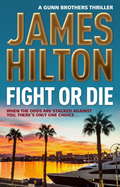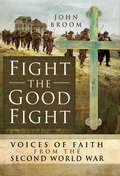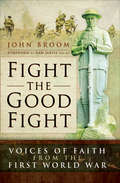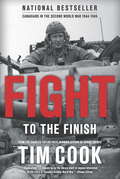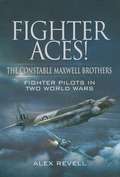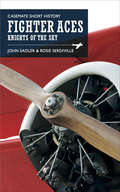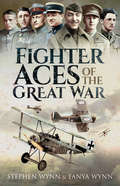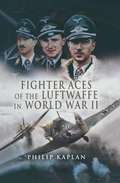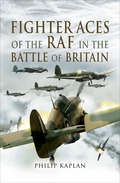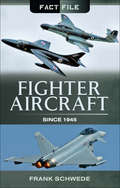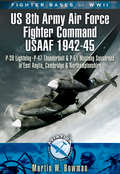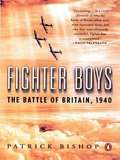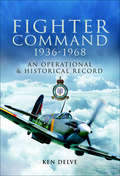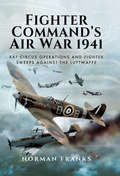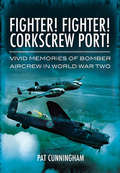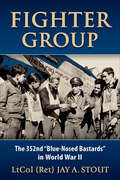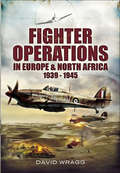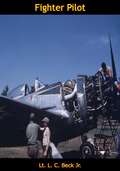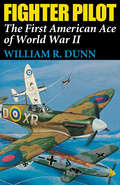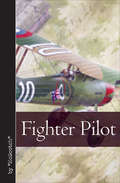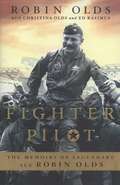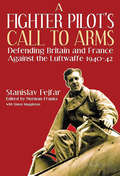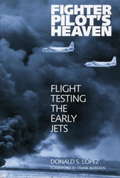- Table View
- List View
Fight or Die: A Gunn Brothers Thriller
by James HiltonBrothers Danny and Clay Gunn were brought up an ocean apart. Both served in the military, and both know how to kill, taking work as private military contractors and freelance “fixers”.When old friends Pamela and Larry are being terrorised by a local gang, keen to scare them away from their beloved business, the brothers step up to help in any way they can. What should be a straightforward job turns ugly when another gang, with a formidable reputation for murder and trafficking, become involved, and suddenly Danny and Clay are thrown into the most trouble they’ve ever faced.But the Gunn brothers aren’t the type to break promises. They came to fight and if they can’t win they’ll die trying...
Fight the Good Fight: Voices of Faith from the Second World War
by John BroomThe Second World War challenged many of the concepts that had provided stability and unity in the world. As totalitarian regimes in Europe and Asia attempted to impose their world view on their neighbours, a struggle for what Winston Churchill described as `Christian civilisation took place on many fronts. On the home front, on land, on sea and in the air, as well as in the horrific concentration camps of Europe and prisoner of war camps in the Far East, people of a Christian faith found their beliefs challenged. However, for many this challenge provided an affirmation of that faith, as it provided a rock amidst the ever shifting sands of circumstance. This book contains the accounts of twenty such individuals, many drawn from previously unpublished sources. Their testimonies provide evidence that during a time of discord, disruption, dislocation and death, the Christian faith remained a key force in sustaining morale and a willingness to fight the good fight.Interesting Facts King George VI called National Days of Prayer during Britains darkest days in 1940Had Michael Benn survived the war, he would have become the 2nd Viscount Stansgate, meaning his brother, Tony, would not have had to fight to renounce his peerageBill Frankland avoided near certain death at the Alexandra Hospital Massacre by the toss of a coinStanley Warren only found out about the rediscovery of his Changi Murals during a chance work conversation in the 1950sAs a boy, Ken Tout was told by his parents to cross the street to avoid walking past the Catholic church. As a man he was invited to a private audience with Pope John Paul II.
Fight the Good Fight: Voices of Faith from the First World War
by John Broom&“The inspiring stories of a number of very different characters who used their Christian faith to cope with their experiences of the First World War.&” —Jacqueline Wadsworth, author of Letters from the Trenches While a toxic mixture of nationalism and militarism tore Europe and the wider world apart from 1914 to 1919, there was one factor that united millions of people across all nations: that of a Christian faith. People interpreted this faith in many different ways. Soldiers marched off to war with ringing endorsements from bishops that they were fighting a Godly crusade, others preached in churches and tribunal hearings that war was fundamentally against the teachings of Christ. Whether Church of England or Nonconformist, Catholic or Presbyterian, German Lutheran or the American Church of Christ in Christian Union, men and women across the globe conceptualized their war through the prism of their belief in a Christian God. This book brings together twenty-three individual and family case studies, some of well-known personalities, others whose stories have been neglected through the decades. Although divided by nation, social class, political outlook, and denomination, they were united in their desire to &‘Fight the Good Fight.&’ &“John Broom looks at such beliefs during the first world war—the Tommies were always fighting for God, the king and their country . . . a fascinating study.&” —Books Monthly &“A detailed study of a usually hidden aspect of wartime social history, the topic of Christian faith. Fight the Good Fight has been meticulously researched and includes a wealth of previously unpublished material.&” —Come Step Back In Time
Fight to the Finish
by Tim CookThe magisterial second volume of Tim Cook's definitive account of Canadians fighting in the Second World War. Historian Tim Cook displays his trademark storytelling ability in the second volume of his masterful account of Canadians in World War II. Cook combines an extraordinary grasp of military strategy with a deep empathy for the soldiers on the ground, at sea and in the air. Whether it's a minute-by-minute account of a gruelling artillery battle, vicious infighting among generals, the scene inside a medical unit, or the small details of a soldier's daily life, Cook creates a compelling narrative. He recounts in mesmerizing detail how the Canadian forces figured in the Allied bombing of Germany, the D-Day landing at Juno beach, the taking of Caen, and the drive south. Featuring dozens of black-and-white photographs and moving excerpts from letters and diaries of servicemen, Fight to the Finish is a memorable account of Canadians who fought abroad and of the home front that was changed forever.
Fight to the Finish
by Jeanette MurrayThe author of Against the Ropes takes her First to Fight series another round with a novel of a JAG officer who loses his cool, when love delivers a knockout punch... Kara is a single mom working hard to keep life running smoothly for herself and her son, but a custody battle is wearing her down. When her friend suggests asking a JAG officer for some unofficial advice, Kara agrees--and soon finds herself officially head over heels... As a Judge Advocate, Graham has seen his share of nasty custody disputes--and he plans on keeping his distance from this one. But this purposeful, passionate woman has a way of drawing him ever closer to the edge. And when Kara's ex starts to throw his weight around, Graham will have to choose between toeing the line or stepping into the ring...
Fighter Aces!: The Constable Maxwell Brothers: Fighter Pilots in Two World Wars
by Alex RevellWhen Gerald Constable Maxwell was flying as a fighter pilot in World War I, his brother Michael was born. Both went on to have distinguished flying careers in World War II. This is the story of both men and how their paths crossed during the second conflict.Gerald served with distinction with 56 Squadron, one of the crack fighter units of WWI in France. Upon his return to England he became Chief Flying Instructor of No. 1 Fighter and Gunnery School at Turnberry. In World War II he served as Station Commander at RAF Ford, a night Fighter station near Arundel, one of the most efficient and happy stations in 11 Group.Michael followed in his brothers footsteps and joined 56 Squadron in April 1940 to fly the Hawker Hurricane. During May the squadron was moved to France to assist the fast retreating British and French forces as the Germans rapidly advanced. On 27 May, he was shot down whilst attacking ten Heinkel 111s on their way to bomb Dunkirk. Fortunately his first contacts upon landing by parachute were French and he managed to find his way to Ostend where he boarded a trawler and crossed the Channel back to Deal.56 Squadron had by now returned to their English base at North Weald from where they were flying patrols over the French coast and escorting RAF bombers raiding the German positions. On 8 June, whilst trying to reach returning Blenheims over Le Treport, the Hurricanes were bounced by Bf 109s and again Michael was hit, wounding him in the leg and foot, fortunately he eventually managed a crash landing back at North Weald. During the height of the Battle of Britain Michael was again forced to make a crash landing near Herne Bay which he was lucky to survive as his Hurricane had disintegrated around him.In the autumn of 1941 Michael was posted to 604 Nightfighter Squadron, led by the legendary Cats Eyes Cunningham flying Beaufighters and eventually Mosquitos. He was eventually to Command the squadron whose tally of enemy aircraft shot down when he left it had reached 100. This remarkable story includes first-hand combat accounts from both Michael and Gerald and the author has had access to the Constable Maxwells family records.
Fighter Aces: Knights of the Skies (Casemate Short History)
by John Sadler Rosie SerdivilleA readable and entertaining introduction to aerial combat in the series that &“would be excellent for someone with an early interest in military history&” (Army Rumour Service). Just over a decade after the first successful powered flight, fearless pioneers were flying over the battlefields of France in flimsy biplanes. Though the infantry in their muddy trenches might see aerial combat as glorious and chivalric, the reality was very different and undeniably deadly: new Royal Flying Corps subalterns in 1917 had a life expectancy of eleven days. In 1915 the term &“ace&” was coined to denote a pilot adept at downing enemy aircraft, and top aces like the Red Baron, René Fonck, and Billy Bishop became household names. The idea of the ace continued after the 1918 Armistice, but as the size of air forces increased, the prominence of the ace diminished. But still, the pilots who swirled and danced in Hurricanes and Spitfires over southern England in 1940 were, and remain, feted as &“the Few&” who stood between Britain and invasion. Flying aircraft advanced beyond the wildest dreams of Great War pilots, the &“top&” fighter aces of World War II would accrue hundreds of kills, though their life expectancy was still measured in weeks, not years. World War II cemented the vital role of air power, and postwar innovation gave fighter pilots jet-powered fighters, enabling them to pursue duels over huge areas above modern battlefields. This entertaining introduction explores the history and cult of the fighter ace from the first pilots through late twentieth-century conflicts, which leads to discussion of whether the era of the fighter ace is at an end.
Fighter Aces of the Great War
by Stephen Wynn Tanya WynnHistory has recorded that the first ever powered flight took place at Kitty Hawk in America, on 17 December 1903 and was carried out by the Wright brothers, Orville and Wilbur, who were aircraft designers and manufacturers. By the time of the outbreak of the First World War, aviation was only eleven years old. The daddy of battlefield warfare until that point in time had been the cavalry, a position it maintained even as war was declared on the Western Front. Aircraft were not initially seen as an offensive weapon and were instead used by both sides as observation platforms, or to take aerial photographs from. Even when they were eventually used in an offensive capacity, they did not have machine guns attached to them; if the crew wanted to open fire then they had to use a pistol or rifle. As the war progressed so the use of aircraft changed from being an observational tool, to that of a fighter and bomber aircraft - something that had never been foreseen at the outbreak of the war. The book then looks at the fighter aces from all sides. These were pilots who had been credited with shooting or forcing down a minimum of five enemy aircraft, of which their were hundreds. While some of these aces survived, many of them were killed. The most famous fighter ace of all is without doubt the German pilot known as the Red Baron, Manfred von Richthofen.
Fighter Aces of the Luftwaffe in World War II
by Philip KaplanThis book examines the reality behind the myths of the legendary German fighter aces of World War II. It explains why only a small minority of pilots - those in whom the desire for combat overrode everything - accounted for so large a proportion of the victories. It surveys the skills that a successful fighter pilot must have - a natural aptitude for flying, marksmanship, keen eyesight - and the way in which fighter tactics have developed. The book examines the history of the classic fighter aircraft that were flown, such as the Messerschmitt Bf 109 and the Focke Wulf Fw 190, and examines each type's characteristics, advantages and disadvantages in combat. The accounts of the experiences of fighter pilots are based on archival research, diaries, letters, published and unpublished memoirs and personal interviews with veterans. The pilots included are Werner Molders, Gunther Rall, Adolf Galland, Erich Hartmann and Johannes Steinhoff.
Fighter Aces of the RAF in the Battle of Britain
by Philip KaplanThis book examines the reality behind the myths of the legendary RAF fighter aces during the Battle of Britain. The accounts of the experiences of fighter pilots are based on archival research, diaries, letters, published and unpublished memoirs and personal interviews with veterans.
Fighter Aircraft Since, 1945 (Fact File)
by Frank SchwedeThe world's first jet engines were already available shortly before the end of the Second World War, but they had not been developed to a high enough standard to take part. This changed after 1945 when, on both sides of the Iron Curtain, one technological development surpassed the others and records tumbled almost every week. The era of the piston engine was finally over and jet fighters now dominated the skies. By the mid-1950s their speed had already reached double that of the speed of sound; an achievement which a few years earlier, would have sounded to many like science fiction.
Fighter Aircraft Since, 1945 (Fact File)
by Frank SchwedeThe world's first jet engines were already available shortly before the end of the Second World War, but they had not been developed to a high enough standard to take part. This changed after 1945 when, on both sides of the Iron Curtain, one technological development surpassed the others and records tumbled almost every week. The era of the piston engine was finally over and jet fighters now dominated the skies. By the mid-1950s their speed had already reached double that of the speed of sound; an achievement which a few years earlier, would have sounded to many like science fiction.
Fighter Bases of WW II US 8th Army Air Force Fighter Command USAAF, 1943–45: P-38 Lightning, P-47 Thunderbolt and P-51 Mustang Squadrons in East Anglia, Cambridgeshire and Northamptonshire
by Martin W. BowmanThis book covers the bases used during the Second World War by the American fighter units that flew in support of the 8th Air Forces heavy bomber forces.The long-range Lightnings, Thunderbolts and Mustangs escorted the Mighty Eighths Flying Fortresses and Liberators on their deep penetration raids into occupied Europe and Germany. Fighter cover was vital, since the USAAF flew daylight raids and in the early months the number of US aircraft lost to the defending Luftwuffe fighters was unacceptably high.The airfields included are Bodney, Bottisham, Boxted, Debden, Duxford, East Wretham, Fowlmere, Halesworth, Honington, Horsham St. Faith, Kings Cliffe, Leiston, Martlesham Heath, Raydon, Steeple Morden, Wattisham and Wormingford.This book looks at the history and personalities associated with each base, what remains today and explores the favorite local wartime haunts where aircrew and ground crew would have sought well-deserved entertainment and relaxation. Other museums and places that are relevant will also be described and general directions on how to get them included.
Fighter Boys
by Patrick BishopThe summer of 1940 was supposed to be the beginning of the end of Britain. Europe had fallen to Hitler's storm troops with terrifying speed, and once the Royal Air Force was destroyed, Britain was next. But that was precisely where the Nazis stumbled. For 123 days, while Herman Goering sent wave after wave of Luftwaffe fighters to rain down fire on Britain, three thousand young RAF airmen fought back with a ferocity and agility that stunned the world. Now in this riveting book, military historian and journalist Patrick Bishop presents the first account of this critical campaign told from the perspective of the pilots themselves. Drawing on interviews with scores of surviving pilots as well as diaries and letters never seen before, Bishop re-creates with astonishing intimacy and clarity this excruciating, exhilarating war of nerves. In their own words, the pilots describe what it felt like when an engine exploded, a parachute failed to open, a swarm of Messerschmitts surrounded their plane, a bomb fell on their home village, a comrade's plane "went in" (their bland term for a high speed crash into the ground). Had the RAF failed, a successful German invasion would have been inevitable-and the pilots knew it. Under unimaginable pressure, these nineteen- and twenty-year-old heroes brought down the world's most powerful air force and saved their nation-and the free world.
Fighter Command, 1936–1968: An Operational & Historical Record
by Ken DelveThis is a comprehensive reference to the structure, operation, aircraft and men of Fighter Command from its formation in 1936 to 1968 when it became part of Strike Command. It includes descriptions of many notable defensive and offensive campaigns, the many types of aircraft used, weapons and airfields. The main sections of the book include a general historical introduction and overview, operations, operational groups, aircrew training and technical details of each aircraft type. Lengthy Annexes cover personnel, the squadrons in World War II, orders of battle for each wartime year, maps of airfield locations and numbers of enemy aircraft downed.
Fighter Commands Air War, 1941: RAF Circus Operations and Fighter Sweeps Against the Luftwaffe
by Norman FranksAn extensive history of the Royal Air Force&’s Circus offensive against Nazi Germany in World War II, by the author of Jasta Boelcke. Following the Battle of Britain, the RAF started taking the air war to the Germans. A small number of bombers, escorted by large numbers of fighters, tried to force the Luftwaffe into battle. Much air combat ensued, but it was not until Germany invaded Russia in June, 1941, that operations were stepped up in an effort to take pressure off Stalin&’s Russian Front. Two major German fighter groups, JG26 and JG2, were, however, more than able to contain the RAF&’s operations, generally only intercepting when conditions were in their favor. As author Norman Franks describes, over-claiming combat victories by pilots of both sides is amazing, and several of the top aces had inflated scores. Fighter Command, however, lost massively even though they believed they were inflicting equal, if not better, losses on the Luftwaffe. This battle of attrition was virtually a reverse of the 1940 battles over England, and pilots who had to bail out over France, were lost completely. The book covers the 100+ Circus operations and their accompanying fighter sweeps in detail, while also mentioning lesser operations where the RAF were concerned. The tactics employed by both sides are examined and show how each fighter force quickly adapted to changing conditions tempered by experiences gained in air combat.
Fighter! Fighter! Corkscrew Port!: Vivid Memories of Bomber Aircrew in World War Two
by Pat CunninghamThe young men who flew with RAF Bomber Command in World War Two were a complex mixture of individuals but they all shared the gift of teamwork. A crew of seven may have comprised all non-commissioned men and some crews included commissioned officers but not always flying as pilots. The outstanding fact was that each man relied on every other member of his crew to return from each mission safely.This book contains ten intriguing reminiscences of bomber aircrew; some were pilots, others navigators, flight engineers, bomb-aimers or gunners. They flew as both commissioned or NCO airmen. Understandably, a common problem was that of coping with fear. Many former aircrew hold that anyone who claims to have felt no fear on operations is either lying or has allowed the years to blank out that fear. But there are a few who do maintain that they never felt afraid. For the majority, though, handling fear was something to be worked out by the individual. Some hit the bottle, others womanized to excess; others tightened the gut and bit the lip; or drew the curtain and focused upon the plotting table or the wireless set. The passing years may have silvered what hair remains, dulled the eye that formerly registered on the merest speck; lent a quiver to the hand that once controlled the stick, penciled in the track, manipulated the tuning dial, set the bombsight, tapped the gauge, or rotated the turret. And yet for all the attributes of age their irrepressible youthfulness shines through.
Fighter Group: The 352nd "Blue-Nosed Bastards" in World War II
by Jay A Stout Lt.Jay Stout breaks new ground in World War II aviation history with this gripping account of one of the war's most highly decorated American fighter groups.
Fighter Operations in Europe and North Africa, 1939–1945
by David WraggFighter Operations in Europe and North Africa 1939–1945 tells the story of Allied and German fighter pilots in Europe, over the Mediterranean and in North Africa during the Second World War. The book starts with the early skirmishes as each side tested the others defenses, moves through the Battle of Britain and then the Blitz, when the emphasis switched from single-engined day fighters to twin-engined night fighters, while increasingly fighters were used to sweep over enemy air fields and lines of communication in occupied France. This overlapped with the need to provide air cover for the besieged island fortress of Malta by day and by night, as well as defensive operations against Axis forces in Crete and North Africa, but as the balance of power changed in North Africa, the Desert Air Force was formed incorporating elements from many Allied air forces and the emphasis moved to offensive operations in support of ground forces. The invasions of Italy and the South of France also called for fighter cover, initially by carrier-based aircraft. The lessons learnt in North Africa were put to good use by the 2nd Allied Tactical Air Force, which accompanied the advancing allied armies towards and eventually into Germany, achieving all important air supremacy which was a major factor in the Allied victory. The book also covers Luftwaffe fighter pilots as they sought to stop the RAF by night and the USAAF by day, against increasingly overwhelming odds.
Fighter Pilot
by Lt. L. C. Beck Jr.Fighter Pilot is the incredible story of a World War II fighter pilot, 1st Lieutenant Levitt Beck, Jr., who was shot down in German-occupied France and hidden by members of the French underground. There he wrote this story of his life practically up until the moment he was discovered. He perished in Buchenwald concentration camp, but his manuscript was delivered to his parents after the war, who took on the responsibility of seeing it published posthumously in 1946.Lt. Beck was shot down near Havelu, Eure-et-Loir, France on 29 June 1944 on an Armed Reconnaissance mission to the Mantes-la-Jolie/Gassicourt area. Although he initially managed to evade capture, he was eventually taken prisoner and, together with more than 167 other Allied airmen, was on a convoy that left Paris on August 18, 1944. He was interned at the Buchenwald concentration camp on August 20, 1944, where he became ill from maltreatment and undernourishment and died of “Lungentuberculosis” (phthisis; pulmonary consumption) in the camp hospital on October 31, 1944, aged 24.His remains were never found and he continues to be listed as MIA (Missing in Action). He is believed to have been cremated in Buchenwald the day following his death. He memorialized at the Luxembourg American Cemetery, Luxembourg City, Great-Duchy of Luxemburg.
Fighter Pilot: The First American Ace of World War II
by William R. DunnAt the age of twelve, American William R. Dunn decided to become a fighter pilot. In 1939 he joined the Canadian Army and was soon transferred to the Royal Air Force. He was the first pilot in the famous Eagle Squadron of American volunteers to shoot down an enemy aircraft and later became the first American ace of the war. After joining the U.S. Army Air Corps in 1943, he saw action in the Normandy invasion and in Patton's sweep across France. Twenty years later he fought again in Vietnam. Dunn keenly conveys the fighter pilot's experience of war -- the tension of combat, the harsh grip of fear, the love of aircraft, the elation of victory, the boisterous comradeship and competition of the pilot brotherhood. Fighter Pilot is both a gripping story and a unique historical document.
Fighter Pilot (Vintage Aviation Library)
by "McScotch" Mannock&“McScotch&” himself describes his book and pays tribute to a colleague in this note, which appears at the front of the volume: &“This book consists of the reminiscences of an ordinary fighter pilot of the R.F.C. who had the privilege of serving in one of the leading Fighter Squadrons and who had the honor of being the friend of the supreme fighter of all the Air Forces, that indomitable and lovable patriot, &‘MICK&’ MANNOCK, V.C., D.S.O., M.C.&” Available records and publications show &“McScotch&” himself as a fighter pilot with 40 Squadron, holding the rank of lieutenant and then captain. He is credited with 12 kills of German opponents. This is a detailed and exciting account of squadron life and shows the bravery and true comradeship of these flyers.
Fighter Pilot: The Memoirs of Legendary Ace Robin Olds
by Robin Olds Christina Olds Ed RasimusThe biography of American fighter pilot Robin Olds, who was a larger-than-life hero with a towering personality.
A Fighter Pilot's Call to Arms: Defending Britain and France Against the Luftwaffe, 1940–1942
by Simon Muggleton Stanislav FejfarThe World War II memoir of a Battle of Britain fighter ace who escaped Czechoslovakia to serve in France and with the RAF in England. Stunned into action by the rapid collapse of his country in 1938, Czech pilot Stanislav Fejfar escaped and traveled through Poland to serve initially with the French Foreign Legion, then as a sous-lieutenant with the French air force in early 1940. After the demise of that country, he fled to England in July 1940 to join the RAF. Posted to 310 Squadron, he saw much feverish action and he rapidly became an ace during the Battle of Britain but was to lose his life on 17 May 1942, shot down over Boulogne flying his beloved Spitfire. Until recently it was not known that throughout his short career, Stanislav kept a full day-by-day diary which has been translated by Henry Prokop and is the basis for this book. Augmented by the diligent research of Norman Franks and Simon Muggleton in unearthing previously unpublished combat reports, letters and other articles of memorabilia, together with their annotated comments, this is an extremely valuable and moving account by a man who gave his life defending freedom. A book which will be sought out by anyone interested in the history of the Battle of Britain.
Fighter Pilot's Heaven: Flight Testing the Early Jets
by Donald S. LopezFighter Pilot's Heaven presents the dramatic inside story of the American military's transition into the jet age, as told by a flyer whose life depended on its success. With colorful anecdotes about fellow pilots as well as precise technical information, Donald S. Lopez describes how it was to be "behind the stick" as a test pilot from 1945 to 1950, when the U.S. military was shifting from war to peacetime operations and from propeller to jet aircraft.An ace pilot who had served with Gen. Claire Chennault's Flying Tiger Fighter Group, Lopez was assigned at the close of World War II to the elite Proof Test Group of the Air Proving Ground Command. Located at Eglin Field (later Eglin Air Force Base) in Florida, the group determined the operational suitability of Air Force weapons systems and aircraft and tested the first operational jet, the P-80 Shooting Star. Jet fighters required new techniques, tactics, and weaponry. Lopez recounts historic test flights in the P-59, P-80, and P-84, among other planes, describing complex combat maneuvers, hair-raising landings in unusual positions, and disastrous crashes and near crashes. This memoir is peppered with lively accounts of many pilots and their colleagues, revealing how airmen coped with both exhilarating successes and sometimes tragic failures.
